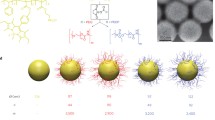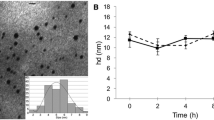Abstract
The physico-chemical properties of nanoparticles (NPs), such as small dimensions, surface charge and surface functionalization, control their capability to interact with cells and, in particular, with sub-cellular components. This interaction can be also influenced by the adsorption of molecules present in biological fluids, like blood, on NP surface. Here, we analysed the effect of serum proteins on 49 and 100 nm red fluorescent polystyrene NP uptake in porcine aortic endothelial (PAE) cells, as a model for vascular transport. To this aim, NP uptake kinetic, endocytic pathway and intracellular trafficking were studied by monitoring NPs inside cells through confocal microscopy and multiple particle tracking (MPT). We demonstrated that NPs are rapidly internalized by cells in serum-free (SF) medium, according to a saturation kinetic. Conversely, in 10% foetal bovine serum-enriched (SE) medium, NP uptake rate results drastically reduced. Moreover, NP internalization depends on an active endocytic mechanism that does not involve clathrin- and caveolae-mediated vesicular transport, in both SE and SF media. Furthermore, MPT data indicate that NP intracellular trafficking is unaffected by protein presence. Indeed, approximately 50–60% of internalized NPs is characterized by a sub-diffusive behaviour, whereas the remaining fraction shows an active motion. These findings demonstrate that the unspecific protein adsorption on NP surface can affect cellular uptake in terms of internalization kinetics, but it is not effective in controlling active and cellular-mediated uptake mechanisms of NPs and their intracellular routes.









Similar content being viewed by others
References
Akerman ME, Chan WC, Laakkonen P, Bhatia SN, Ruoslahti E (2002) Nanocrystal targeting in vivo. Proc Natl Acad Sci USA 99(20):12617–12621
Blocker A, Severin FF, Burkhardt JK, Bingham JB, Yu H, Olivo JC, Schroer TA, Hyman AA, Griffiths G (1997) Molecular requirements for bi-directional movement of phagosomes along microtubules. J Cell Biol 137(1):113–129
Brannon-Peppas L, Blanchette JO (2004) Nanoparticle and targeted systems for cancer therapy. Adv Drug Deliv Rev 56(11):1649–1659
Caspi A, Yeger O, Grosheva I, Bershadsky AD, Elbaum M (2001) A new dimension in retrograde flow: centripetal movement of engulfed particles. Biophys J 81(4):1990–2000
Chithrani BD, Ghazani AA, Chan WC (2006) Determining the size and shape dependence of gold nanoparticle uptake into mammalian cells. Nano Lett 6(4):662–668
Conner SD, Schmid SL (2003) Regulated portals of entry into the cell. Nature 422:37–44
de Gennes PG (1976) La percolation: Un concept unificateur. La Recherche 7(72):919–927
Decuzzi P, Ferrari M (2006) The adhesive strength of non-spherical particles mediated by specific interactions. Biomaterials 27(30):5307–5314
Decuzzi P, Ferrari M (2007) The role of specific and non-specific interactions in receptor-mediated endocytosis of nanoparticles. Biomaterials 28(18):2915–2922
Decuzzi P, Ferrari M (2008) Design maps for nanoparticles targeting the diseased microvasculature. Biomaterials 29(3):377–384
Desai MP, Labhasetwar V, Walter E, Levy RJ, Amidon GL (1997) The mechanism of uptake of biodegradable microparticles in caco-2 cells is size dependent. Pharm Res 14(11):1568–1573
Doherty GJ, McMahon HT (2009) Mechanisms of endocytosis. Annu Rev Biochem 78:857–902
Ehrenberg MS, Friedman AE, Finkelstein JN, Oberdörster G, McGrath JL (2009) The influence of protein adsorption on nanoparticle association with cultured endothelial cells. Biomaterials 30(4):603–610
Ewers H, Smith AE, Sbalzarini IF, Lilie H, Koumoutsakos P, Helenius A (2005) Single-particle tracking of murine polyoma virus-like particles on live cells and artificial membranes. Proc Natl Acad Sci USA 102(42):15110–15115
Gbadamosi JK, Hunter AC, Moghimi SM (2002) Pegylation of microspheres generates a heterogeneous population of particles with differential surface characteristics and biological performance. FEBS Lett 532(3):338–344
Golding I, Cox EC (2006) Physical nature of bacterial cytoplasm. Phys Rev Lett 96(9):098102
Harush-Frenkel O, Debotton N, Benita S, Altschuler Y (2007) Targeting of nanoparticles to the clathrin-mediated endocytic pathway. Biochem Biophys Res Commun 353:26–32
Hillaireau H, Couvreur P (2009) Nanocarriers’ entry into the cell: relevance to drug delivery. Cell Mol Life Sci 66(17):2873–2896
Hong S, Leroueil PR, Janus EK, Peters JL, Kober MM, Islam MT, Orr BG, Baker JR Jr, Banaszak Holl MM (2006) Interaction of polycationic polymers with supported lipid bilayers and cells: nanoscale hole formation and enhanced membrane permeability. Bioconjug Chem 17(3):728–734
Huang M, Ma Z, Khor E, Lim L (2002) Uptake of FITC chitosan nanoparticles by A549 cells. Pharm Res 19:1488–1494
Jiang W, Kim BY, Rutka JT, Chan WC (2008) Nanoparticle-mediated cellular response is size-dependent. Nat Nanotechnol 3(3):145–150
Jin H, Heller DA, Strano MS (2008) Single-particle tracking of endocytosis and exocytosis of single-walled carbon nanotubes in nih-3t3 cells. Nano Lett 8(6):1577–1585
Johnston HJ, Semmler-Behnke M, Brown DM, Kreyling W, Tran L, Stone V (2010) Evaluating the uptake and intracellular fate of polystyrene nanoparticles by primary and hepatocyte cell lines in vitro. Toxicol Appl Pharmacol 242(1):66–78
Kim W, Choi HC, Shim M, Li Y, Wang D, Dai H (2002) Synthesis of ultralong and high percentage of semiconducting single-walled carbon nanotubes. Nano Lett 2(7):703–708
Labhasetwar V, Song C, Humphrey W, Shebuski R, Levy RJ (1998) Arterial uptake of biodegradable nanoparticles: effect of surface modifications. J Pharm Sci 87(10):1229–1234
Lai SK, Hida K, Man ST, Chen C, Machamer C, Schroer TA, Hanes J (2007) Privileged delivery of polymer nanoparticles to the perinuclear region of live cells via a non-clathrin, non-degradative pathway. Biomaterials 28(18):2876–2884
Lai SK, Hida K, Chen C, Hanes J (2008) Characterization of the intracellular dynamics of a non-degradative pathway accessed by polymer nanoparticles. J Control Release 125(2):107–111
Limbach LK, Li Y, Grass RN, Brunner TJ, Hintermann MA, Muller M, Gunther D, Stark WJ (2005) Oxide nanoparticle uptake in human lung fibroblasts: effects of particle size, agglomeration, and diffusion at low concentration. Environ Sci Technol 39(23):9370–9376
Lundqvist M, Stigler J, Elia G, Lynch I, Cedervall T, Dawson KA (2008) Nanoparticle size and surface properties determine the protein corona with possible implications for biological impacts. Proc Natl Acad Sci USA 105(38):14265
Mao S, Germershaus O, Fischer D, Linn T, Schnepf R, Kissel T (2005) Uptake and transport of PEG-graft-trimethyl-chitosan copolymer-insulin nanocomplexes by epithelial cells. Pharm Res 22:2058–2068
Mineo C, Anderson RG (2001) Potocytosis Robert feulgen lecture. Histochem Cell Biol 116(2):109–118
Muro S, Koval M, Muzykantov V (2004) Endothelial endocytic pathways: gates for vascular drug delivery. Curr Vasc Pharmacol 2(3):281–299
Oberdörster G, Oberdörster E, Oberdörster J (2005) Nanotoxicology: an emerging discipline evolving from studies of ultrafine particles. Environ Health Perspect 113(7):823
Owens DE III, Peppas NA (2006) Opsonization, biodistribution, and pharmacokinetics of polymeric nanoparticles. Int J Pharm 307(1):93–102
Panyam J, Labhasetwar V (2003) Biodegradable nanoparticles for drug and gene delivery to cells and tissue. Adv Drug Deliv Rev 55(3):329–347
Panyam J, Labhasetwar V (2004) Targeting intracellular targets. Curr Drug Deliv 1(3):235–247
Peetla C, Labhasetwar V (2008) Biophysical characterization of nanoparticle-endothelial model cell membrane interactions. Mol Pharm 5(3):418–429
Qaddoumi MG, Gukasyan HJ, Davda J, Labhasetwar V, Kim KJ, Lee VH (2003) Clathrin and caveolin-1 expression in primary pigmented rabbit conjunctival epithelial cells: role in plga nanoparticle endocytosis. Mol Vis 9:559–568
Rappoport JZ (2008) Focusing on clathrin-mediated endocytosis. Biochem J 412(3):415–423
Rejman J, Oberle V, Zuhorn IS, Hoekstra D (2004) Size-dependent internalization of particles via the pathways of clathrin- and caveolae-mediated endocytosis. Biochem J 377(Pt 1):159–169
Rothen-Rutishauser BM, Schurch S, Haenni B, Kapp N, Gehr P (2006) Interaction of fine particles and nanoparticles with red blood cells visualized with advanced microscopic techniques. Environ Sci Technol 40(14):4353–4359
Sbalzarini IF, Koumoutsakos P (2005) Feature point tracking and trajectory analysis for video imaging in cell biology. J Struct Biol 151(2):182–195
Serda RE, Gu J, Bhavane RC, Liu X, Chiappini C, Decuzzi P, Ferrari M (2009) The association of silicon microparticles with endothelial cells in drug delivery to the vasculature. Biomaterials 30(13):2440–2448
Stan RV (2002) Structure and function of endothelial caveolae. Microsc Res Tech 57(5):350–364
Swanson JA, Watts C (1995) Macropinocytosis. Trends Cell Biol 5(11):424–428
Tantra R, Tompkinsa J, Quinceya P (2010) Characterisation of the de-agglomeration effects of bovine serum albumin on nanoparticles in aqueous suspension. Colloids Surf B Biointerfaces 75(1):275–281
Tolic-Norrelykke IM, Munteanu EL, Thon G, Oddershede L, Berg-Sorensen K (2004) Anomalous diffusion in living yeast cells. Phys Rev Lett 93(7):078102
Verma A, Uzun O, Hu Y, Hu Y, Han HS, Watson N, Chen S, Irvine DJ, Stellacci F (2008) Surface-structure-regulated cell-membrane penetration by monolayer-protected nanoparticles. Nat Mater 7(7):588–595
Wang Z, Tiruppathi C, Minshall RD, Malik AB (2009) Size and dynamics of caveolae studied using nanoparticles in living endothelial cells. ACS Nano 3(12):4110–4116
Xia T, Rome L, Nel A (2008) Nanobiology: particles slip cell security. Nat Mater 7(7):519–520
Yacobi NR, Malmstadt N, Fazlollahi F, DeMaio L, Marchelletta R, Hamm-Alvarez SF, Borok Z, Kim KJ, Crandall ED (2010) Mechanisms of alveolar epithelial translocation of a defined population of nanoparticles. Am J Respir Cell Mol Biol 42(5):604–614
Author information
Authors and Affiliations
Corresponding author
Additional information
The first three authors contributed equally to this work.
Rights and permissions
About this article
Cite this article
Guarnieri, D., Guaccio, A., Fusco, S. et al. Effect of serum proteins on polystyrene nanoparticle uptake and intracellular trafficking in endothelial cells. J Nanopart Res 13, 4295–4309 (2011). https://doi.org/10.1007/s11051-011-0375-2
Received:
Accepted:
Published:
Issue Date:
DOI: https://doi.org/10.1007/s11051-011-0375-2




